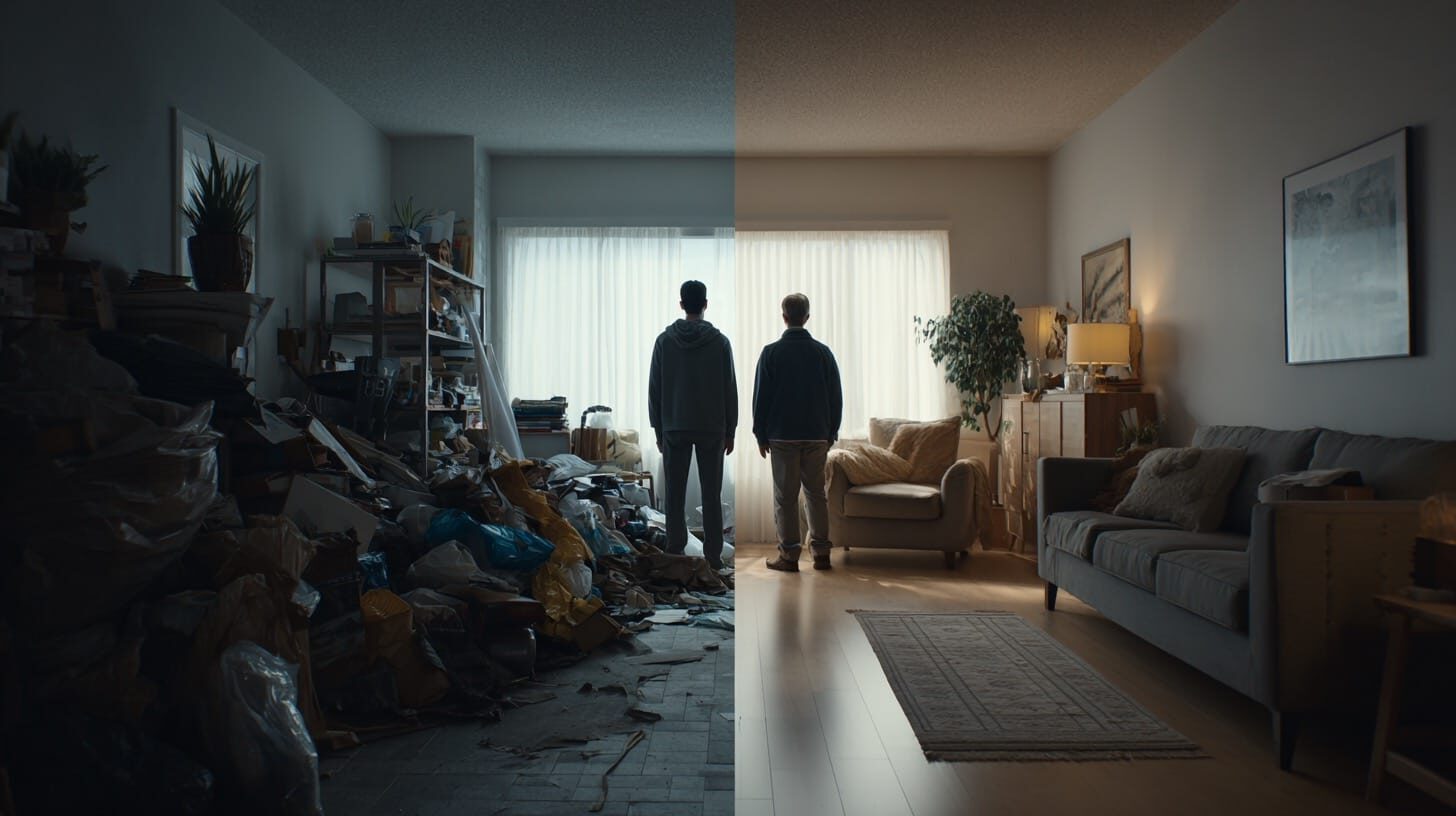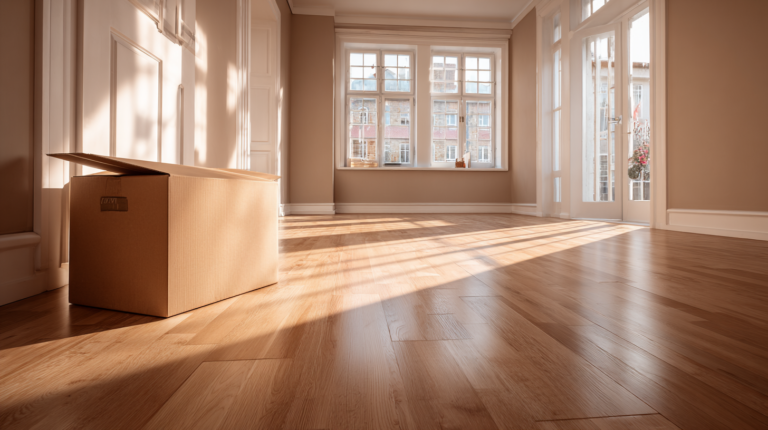If you’ve ever opened a door and felt junk “lean back” at you… you know the vibe. It’s not just clutter. It’s stress, risk, and money quietly leaking out of your property every day. Whether you’re a landlord who needs units rent-ready or a homeowner trying to protect your investment, letting stuff stack up has real, measurable downsides.
Let’s walk through what’s actually at stake—the dollars and cents, the safety hazards, the legal landmines—and how to get ahead of it before a small mess becomes a big (and expensive) headache.
What “Cost of Hoarding” Really Means (and Why It Adds Up Fast)
Hoarding isn’t just “a lot of stuff.” It’s a pattern of acquiring and keeping items that overwhelms living spaces and blocks normal use of the home. The ripple effects are brutal: lost rent, steep cleanout bills, damaged systems, and longer days on market when you try to sell. The cost of hoarding is really a bundle of costs that feed each other.
1) Direct cleanup and disposal
- Labor + hauling + disposal fees: Professional cleanouts price by volume, difficulty (stairs, access), sorting, and special handling. Estate/whole-home cleanouts commonly run into four figures; national project data often centers around the low-to-mid thousands, and climbs quickly when heavy items, stairs, biohazards, or multiple dumpsters are involved.
- DIY doesn’t stay cheap: It looks cheaper until you’re on your third truck run, paying landfill/dump fees, losing a weekend (or three), and buying gear—gloves, masks, contractor bags, tarps, a hand truck—you didn’t budget for. And if you injure yourself? That’s a cost, too.
2) Opportunity cost (the sneakiest one)
- Lost rent: Every extra week a unit isn’t showable is a week of revenue gone.
- Lower sale price / longer time on market: Buyers mentally tally “work to do.” Visible junk telegraphs neglect and hides defects, which spooks offers or drags them down.
3) Repair escalation
- Junk blocks access to shutoff valves, HVAC filters, and service panels. Small leaks become subfloor rot. A tripped breaker becomes a “no heat” call because the panel’s buried. The longer you wait, the higher the bill later.
Bottom line: the cost of hoarding compounds. One problem breeds three more.
“Junk Pile Risks”: Health, Safety, and Insurance (the un-fun trio)
Okay, let’s talk about the part no one wants to think about: safety. Accumulated stuff raises the stakes in real emergencies.
Fire risk ramps up
Excess fuel loads (paper, textiles, packaging) and blocked pathways mean faster-moving fires and harder, slower rescues. Cooking and heating equipment surrounded by combustibles is a known hazard, and cluttered homes are demonstrably more dangerous for occupants and first responders.
Pests and mold love clutter
Stacks hide moisture and food sources. That’s an invitation to rodents, cockroaches, and mold—all costly to remediate and tough on tenant health, especially for kids and older adults.
Trip/egress hazards = liability
Blocked exits and narrowed pathways increase fall risk and can violate local housing codes. If someone is hurt—or can’t evacuate quickly—expect scrutiny from insurers and code officials.
And yes, claims can get messy if inspections note chronic hazards that went unaddressed. Even if a policy ultimately pays, you’re now in “document everything” territory.
Legal and Compliance Exposure (Landlords: read this twice)
Here’s where it gets complicated—and where compassion plus good paperwork pays for itself.
Hoarding and fair housing
Hoarding disorder is recognized as a mental health condition. Under the Fair Housing Act, housing providers must consider reasonable accommodations for tenants with disabilities—things like time-bound cleanup plans or coordination with services—before moving to terminate a tenancy (so long as the accommodation is feasible and doesn’t pose an immediate danger). The key is to address verified health and safety issues while complying with fair housing law.
Practical translation:
- You can (and should) enforce lease standards related to safety, access, pests, and sanitation.
- You should document conditions and offer a clear, reasonable path to remedy when disability is involved.
- You shouldn’t evict solely for hoarding if a reasonable accommodation would resolve the hazardous conditions. (When imminent danger exists, act immediately and involve professionals.)
Code compliance, fines, and forced abatement
If conditions violate local codes (blocked egress, infestation, unsafe wiring, exterior junk attracting pests), you can face fines, compliance orders, and—if ignored—forced abatement at your expense. That’s the slow, expensive way to learn a lesson.
The Real Math: DIY vs. Professional Cleanout
I get it—rolling up your sleeves can feel satisfyingly thrifty. But hoarding and heavy junk cleanouts are where pros genuinely save money.
Why professionals often net out cheaper
- Speed: A trained crew with the right gear, trucks, and disposal relationships can do in hours what takes DIYers days (or weeks). Quick turns = faster rent.
- Safety + compliance: Pros understand local disposal rules, donation channels, e-waste, chemicals, and biohazard protocols, reducing legal exposure and rework.
- Sorting for value: Good teams will triage for donation/resale, which can reduce disposal volume and occasionally offset costs—something DIYers intend to do but rarely finish well.
When DIY makes sense
- Light, non-hazardous clutter where you can donate or bulk-pickup easily, and you already have a truck and help.
- You’re truly time-rich and cash-constrained… and you’re realistic about the number of trips and dump fees.
For everything else—especially where junk pile risks include pests, mold, blocked exits, or appliances/furniture that require two lifters—bring in help early. You’ll save money by avoiding the second cleanup you didn’t plan for.
Early Warning Signs (and what to do about them)
Landlords and homeowners can catch problems before they explode. Watch for:
- Access issues: Techs can’t reach HVAC filters, panels, or shutoff valves.
- Pathways shrinking: Hallways and exits narrowed by bags or boxes.
- Odors/pests: Neighbors report smells, droppings, or sightings.
- Exterior overflow: Porches/garages become spillover storage.
- Missed inspections: Rescheduled or refused entry multiple times.
When you spot these, move quickly and thoughtfully.
- Document with dates, photos, and neutral language. Stick to observable safety/sanitation concerns.
- Reference lease standards (housekeeping, access for repairs, no obstructions) and set a specific timeline to remedy.
- If disability is disclosed or suspected, offer a reasonable accommodation plan. That could include phased clean-outs, extra time, and coordination with a removal service or community resources.
- Bring in licensed pros for removal and (if needed) remediation.
- Schedule follow-ups to verify sustained progress.
Health & Human Side: Why a soft approach works better (and faster)
Hoarding disorder often co-exists with anxiety, depression, or trauma. Using shame or threats tends to freeze progress. A clear, calm, stepwise plan with support gets better outcomes and protects your investment.
Need a one-liner for your notice? Try:
“For safety and compliance, we need clear pathways to exits, working smoke detectors, and access to HVAC/plumbing. Let’s create a phased plan that works for you and meets code.”
For context and empathy around hoarding disorder itself, clinical sources outline why discarding is difficult and why progress can be slow but meaningful with the right support.
Sample Lease & Policy Language You’ll Be Glad You Added
(Keep this in your toolkit for renewals and new tenants.)
Housekeeping & Safety Standards
- Pathways, exits, windows, and doors must remain clear to full width/height.
- Working smoke/CO detectors must be accessible and unobstructed.
- Cooking and heating appliances must have clearances free of combustibles.
- Pests/odors must be promptly addressed with management-approved treatment.
Access for Maintenance & Inspections
- Landlord must be able to access areas requiring periodic service (HVAC filters, electrical panels, shutoffs, appliances).
- Tenant agrees to maintain conditions allowing safe entry for repairs and inspections as allowed by law with proper notice.
Corrective Plans / Reasonable Accommodation
- If conditions pose health/safety risks and a disability is involved, a written, time-bound accommodation plan may be offered to restore the unit to code within a reasonable timeframe.
Always have your attorney review language for your jurisdiction.
A Simple, Step-by-Step Cleanout Plan
Phase 1: Safety First (same day to 72 hours)
- Clear egress paths to full width.
- Verify smoke/CO detectors and fire extinguishers are accessible.
- Unblock electrical panels and shutoffs.
- Remove spoiled food and obvious trash.
Phase 2: Hazard Controls (1–2 weeks)
- Junk removal for bulk items; schedule dumpster or crew.
- Target moisture zones (kitchen, baths, laundry) to check for mold/water.
- Treat pests promptly (integrated pest management works best).
Phase 3: Deep Reset (2–4 weeks)
- Donate/resell salvageable items; dispose of the rest.
- Clean surfaces; replace filters; service HVAC.
- Make minor repairs uncovered by the cleanout (leaks, soft floors, damaged trim).
Phase 4: Prevention (ongoing)
- Quarterly filter swaps and safety walk-throughs.
- Clear lease expectations and friendly reminders before inspections.
- For returning tendencies, re-engage supports or accommodations, as needed.
FAQ: Quick Answers Landlords & Homeowners Ask
How much does a “typical” cleanup cost?
There’s no true typical. Small jobs can be under $1,000; whole-home/estate cleanouts often land in the low-to-mid thousands and climb with stairs, volume, hazardous materials, appliance handling, and multiple dumpsters. Obtain on-site quotes (not just phone estimates) and ask what’s included—labor, disposal, donation, and sweep-out.
Can I evict a tenant for hoarding?
You can enforce health/safety standards and lease terms. If hoarding disorder is involved, you must consider reasonable accommodations that correct hazards. When imminent danger exists, act fast and involve professionals. Document everything.
Is hoarding really that dangerous in a fire?
Yes. Heavy fuel loads, blocked exits, and delayed discovery/egress increase risk for residents and first responders.
What about the human side—won’t they just re-accumulate?
Relapse can happen. Pair cleanup with supports and clear standards. Consistent follow-ups and a respectful approach go much farther than shame.
The Takeaway (and Your Next Best Step)
Letting junk pile up is more than an eyesore. It’s a compound-interest problem—higher cost of hoarding, bigger junk pile risks, and deeper legal exposure the longer you wait. Tackle it early with a calm plan, professional help where it counts, and documentation that protects everyone.
Ready to reclaim your space and reduce risk?
Get a fast, compliant cleanout that gets your unit back on the market (or your home back to peaceful) sooner—without the weekend warrior backache.





